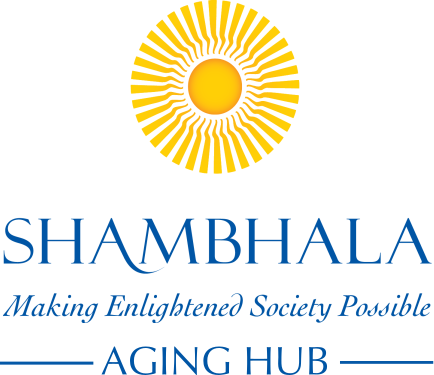By Jacquie Bell.
Caring for someone at the end of their life can be both an honor and a challenge. An ”honor” because we are called upon to be truly “present” at a time when our hearts and the person’s (and their family’s) are the most open and vulnerable. A “challenge” because our own preconceived notions about what a “good death” is, can be an obstacle to providing what is needed at the time.
Lisa Hilliard was a much-beloved practitioner, teacher and friend to many in our community. She had done a three-year retreat, taught for Naropa University in Asia, and loved teaching the dharma to the Shambhala sangha. In May, 2008, I attended a program she was teaching at the Halifax Shambhala Centre where she complained of a cough that wouldn’t go away. When her doctor sent her to get x-rays, cancer was discovered in the lining of her lungs. She died before the end of August.
Lisa lived alone in an apartment close to the Shambhala Centre at the time. Her dekyong, Janet Shotwell, put out a message to Lisa’s neighbours and friends, and started a circle of care for her. After a while it became clear that her needs were too great for her to remain in her apartment, and two gracious and generous practitioners, Susan and Steve Peters, offered to take her into their home. Susan is a nurse, and everyone felt relieved that she would be able to be the primary caregiver, though she was still working part-time. Her friends continued to visit with her and bring food. After a while, Lisa’s sister arranged to have nursing at night for her.
The palliative care home consult team began coming to the home right away to provide care and medications for comfort control. A week or so before her death, the palliative care physician ordered an increase in her morphine dosage as Lisa started having more trouble breathing, and morphine is the go-to medication for that symptom, which can be more stressful and harder to manage than pain.
This caused much concern for many of Lisa’s friends. To struggle to breathe is terrible, but they were concerned she would be too groggy from the medication to be able to be alert at the time of her death. This was not a particular concern to me, as I knew that, while morphine does make someone sleepy for a couple of days after it is started, that first effect will wear off. And, if the medication is titrated properly, the person will be able to be as alert as they were before starting it. In fact, as Susan Peters, described the situation, “…the morphine very much helped Lisa to maintain her clarity of mind – by making it possible for her to breathe more easily – so that she could focus on her practice and continue to prepare for her approaching death.”
Within a couple of days of Lisa starting the increase of the drug, I received a book in the mail, BEING WITH DYING, by Joan Halifax. I picked it up to peruse it, and it fell open to page 76. On that page, Roshi Joan is recalling a conversation she had with HH the Dalai Lama. She writes:
“I asked His Holiness if he thought that the mind was at risk if strong drugs were used to help relieve severe pain. He said emphatically that even if medications cloud the mind, the mind-ground is what is liberated at the moment of death. If the deceased has had a strong practice in life, then the way is clear for becoming one with the nature of mind at the moment of death, no matter what medications have been used.”
A bit awed with the auspicious coincidence of discovering that teaching, I went to Lisa’s bedside and read the passage to her. She asked me to read it three times. I then made a copy for the rest of her friends to read when they came to provide care or to visit with her.
I have since used that teaching many times in presenting end-of-life care for practitioners. It’s both an inspiration to practice now, and also a relief to know that, even if a person has Alzheimer’s or is unconscious, or even brain-dead from an accident at the time of death, the result of their practice will enable the person to be “awake” as they continue their journey.
(Molecular structure of morphine from Wikipedia is in the public domain.)

